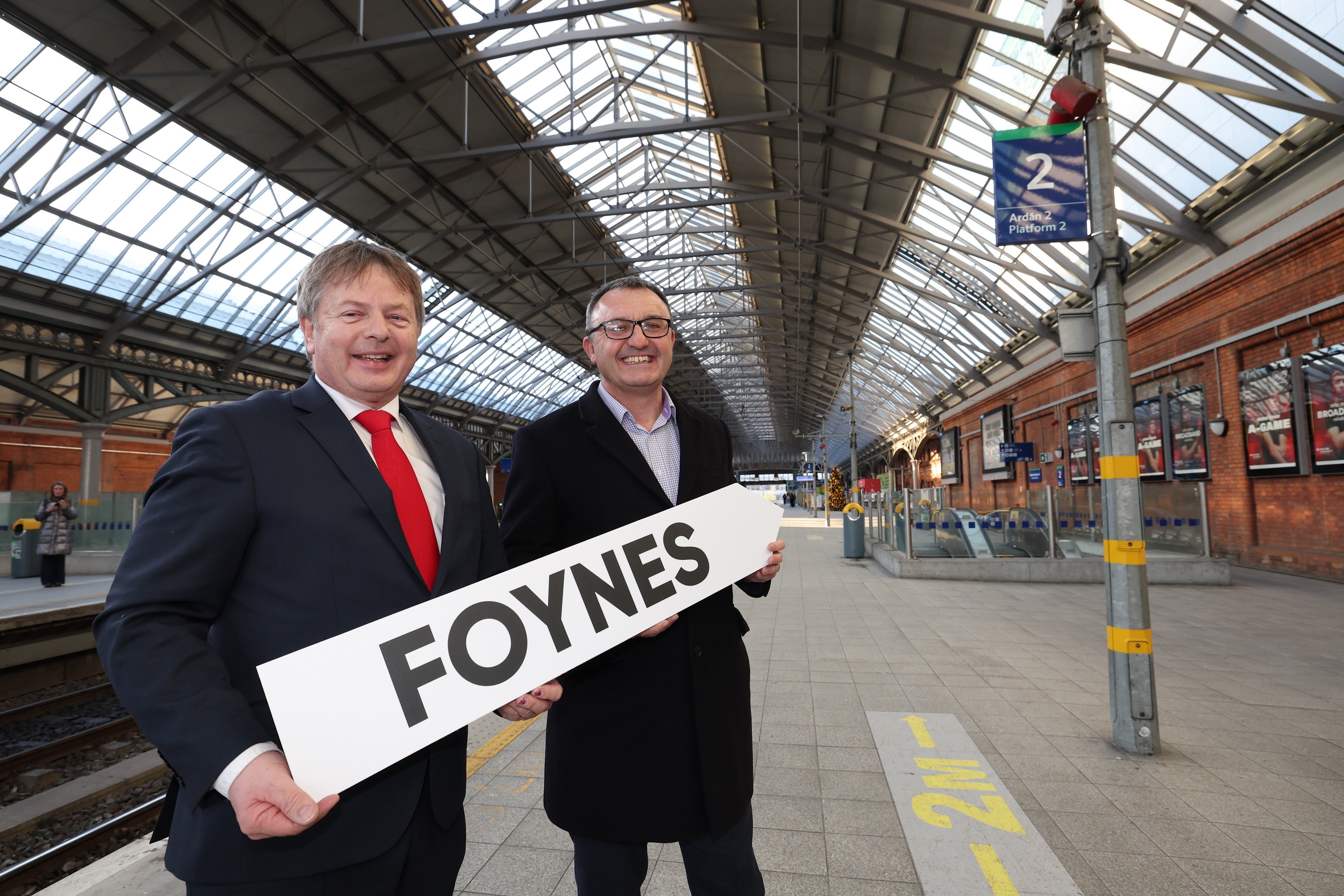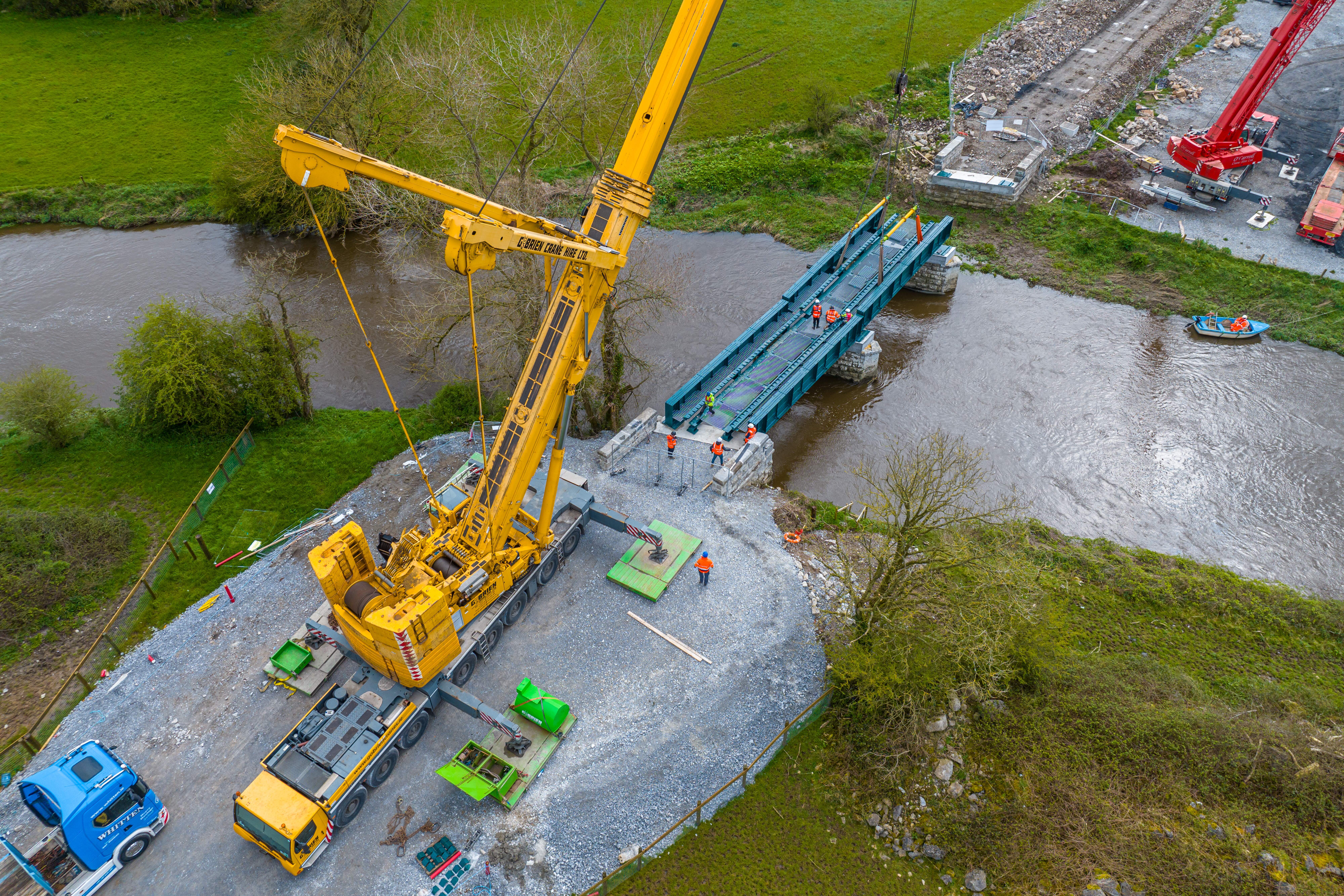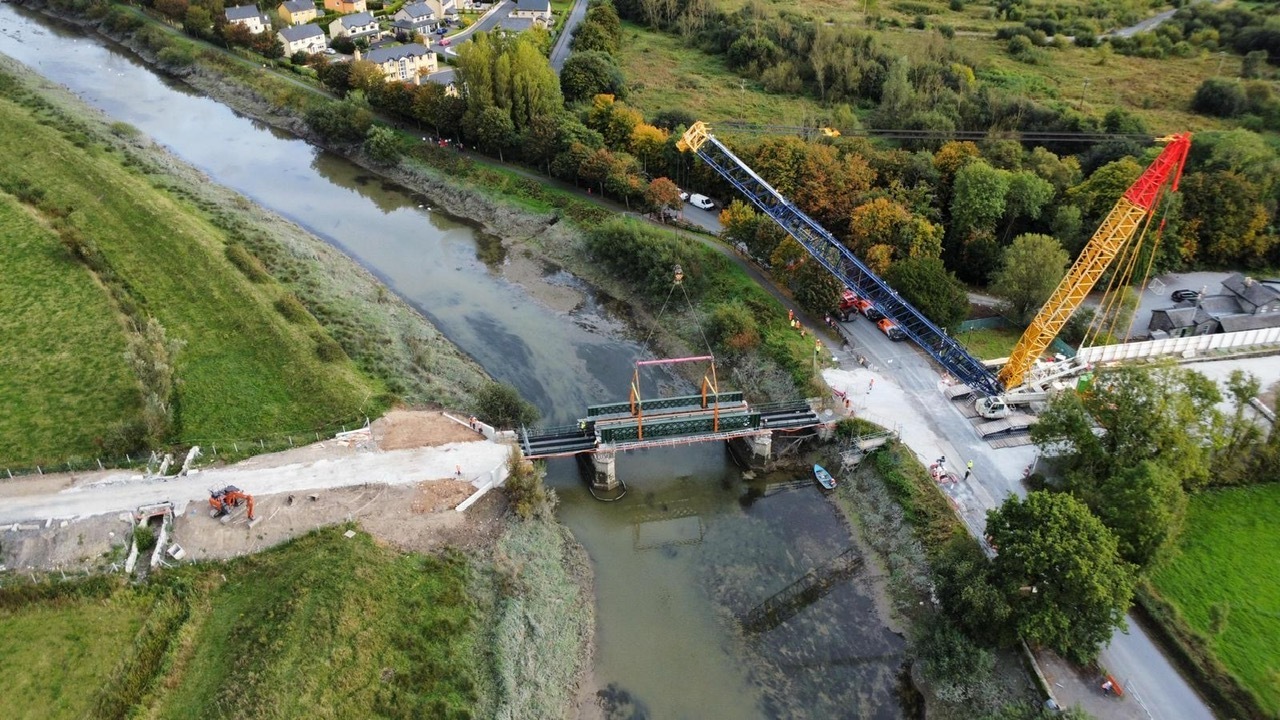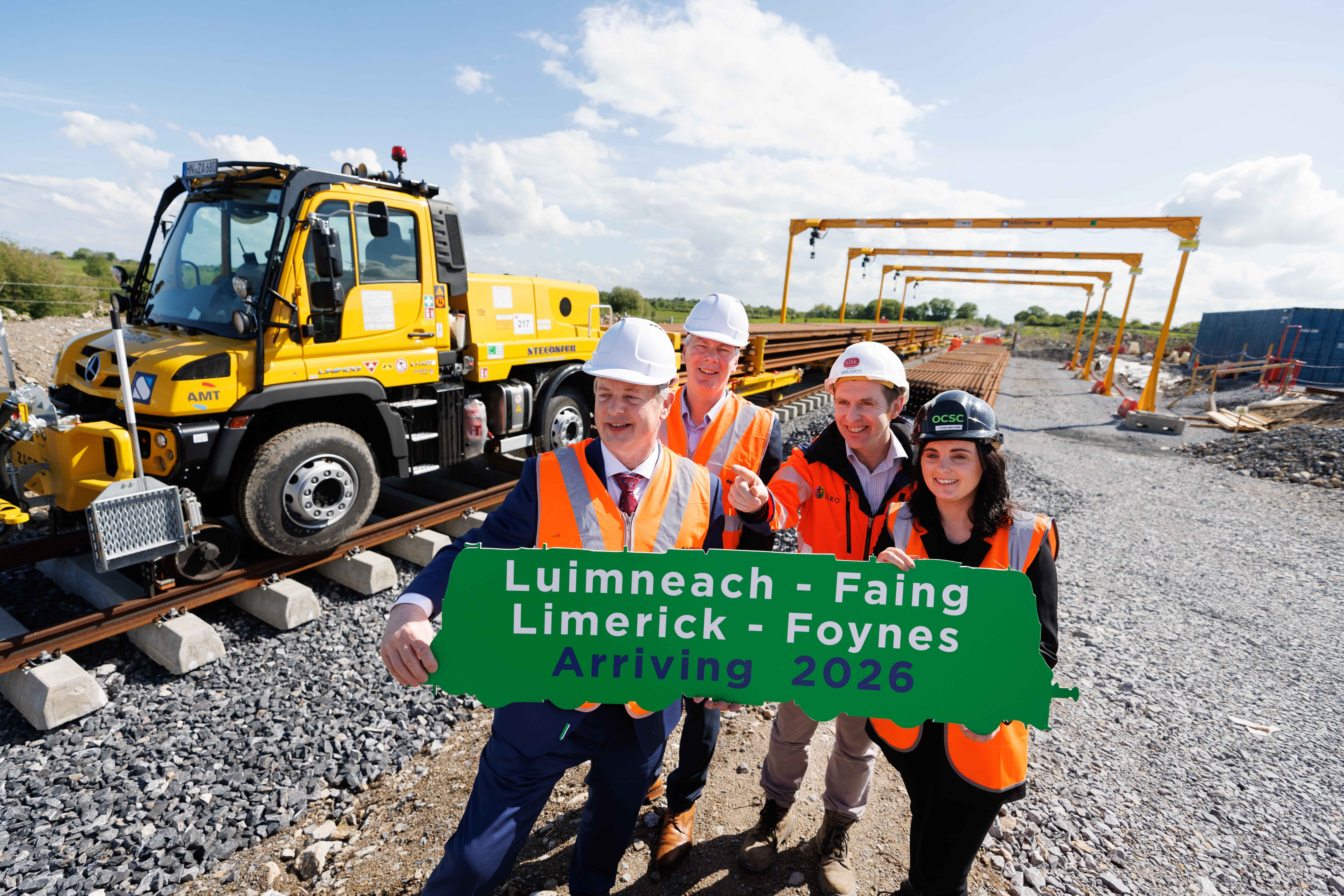A disused railway line in the west of Ireland is being brought back to life as a first step in Iarnród Éireann’s (Irish Rail’s) strategy to encourage a switch of freight from road to rail.
It is more than two decades since the last train travelled the 42km west from the city of Limerick in the south west of Ireland to Foynes Port on the River Shannon estuary. But despite being mothballed at the turn of the century, the route remained under Iarnród Éireann ownership. Now the ballast is being renewed, rails laid and level crossings automated for what Iarnród Éireann intends to be the debut of a new rail freight network for Ireland.
In its previous conception from its opening in 1858, the Limerick to Foynes line predominantly carried freight, including minerals such as zinc, lead and barytes ore for export and imports of coal and oil. During the 1930s, trains also included passenger coaches. But demand slowed drastically in the late 20th century and services ceased in 2001.
The move to reopen the line was prompted by the Shannon Foynes Port Company (SFPC), which owns and operates what is Ireland’s deepest sheltered commercial harbour. With water depths of up to 32m and an estuary that flows straight into the Atlantic Ocean, the port is accessible from the world’s busiest shipping routes, and currently has capacity to handle over 10Mt of cargo annually.

Additionally, with 1,200ha of land earmarked for port development, the company claims to be uniquely positioned to expand as an international cargo hub serving the domestic, European and worldwide markets. More recently, SFPC has been highlighting its location as ideal for building and servicing infrastructure for floating wind farms, and to act as a hub for Ireland’s decarbonisation journey.
Getting freight on the railways is a central part of the port company’s aspirations; and having a railway connection in place by 2030 is also a pre-requisite for Foynes Port to retain its status as part of the Trans-European Transport Network (Ten-T).
Project history
Back in 2014, SFPC took the first step by funding a scoping study to investigate the practicalities of reinstating the line. A preliminary design was completed in 2015 and a detailed design in 2019, carried out by Iarnród Éireann and its consultant O’Connor Sutton Cronin and co-funded by the European Commission’s Connecting Europe Facility.
In 2021, when Iarnród Éireann published its Rail Freight 2040 Strategy, the Limerick-Foynes link was highlighted as crucial for supporting the expansion of the port and encouraging customers to move freight back onto rail.
Sisk was awarded the €65M contract for the civils phase of the project and started on site in February 2023. The scheme has a total budget of €151.5M and the civils work is due to complete in early 2025, with line opening scheduled for early 2026. The project is funded by Ireland’s Department of Transport and National Transport Authority.
The current project is “100% a freight line” according to Iarnród Éireann; but although no stations are being built as part of this current scheme, the work that is being done will not rule out future introduction of passenger services if a decision is taken to pursue this.

Structures
The 42km-long freight line features six main structures – five underbridges and an overbridge – and a further 36 smaller structures, 78km of lineside fencing and the introduction of CCTV-monitored and automated operation of the 13 level crossings on public roads. There are a further 50 user-operated access crossings for farmers and landowners across the length of the scheme.
The line is single track across the majority of the route with a couple of passing loops, and is expected to carry around 10 trains in each direction within a 12-hour operating period when it opens.
Once site clearance of vegetation had taken place, all the remaining ballast, sleepers and rails on the line had to be removed for disposal.
Four of the five underbridges have been repaired and refurbished, while the largest, the 42m-long Robertstown Viaduct has been replaced with a new superstructure and abutments. Most of the other overbridges and underbridges are masonry structures where repointing and new parapets have been the main focus of the work.
One of the major challenges of the project is logistics and access to the site, reveals Sisk project manager Noel Curtis. “The scheme is 42km long and very narrow in places, which affected our selection of plant and equipment. From a programme point of view, we couldn’t afford to start at one end and work towards the other – we had to split it up and gain access at multiple points to have sufficient flexibility and robustness in the programme,” he says.
With the 5.5m-wide trackbed squeezed between fences separated by just 6m in places – and 15m at best – work on one part of the scheme would often block access to the rest of that section. Added to that, some of the main bridges were taken away for refurbishment, isolating parts of the site for several months while they were upgraded.
“From day one, we took the view that we would lift the bridges out rather than refurbish them in situ,” says Merriman. “That had programme savings as well as addressing the fact that we had environmental constraints in most of those locations.”

Access was again a factor in these decisions – the width of the riveted bridge span over the River Maigue at Adare prevented it being transported on the public highway, so it was refurbished on adjacent land, whereas the River Deel spans were taken offsite. Both were renovated by specialist subcontractor Mack Engineering.
At Robertstown Viaduct, the existing three-span bridge had come to the end of its life and consulting engineer O’Connor Sutton Cronin proposed a single-span replacement structure. The old bridge was supported on two piled piers in the Robertstown River, a tidal tributary of the River Shannon and a protected environment.
The decision to use a single-span replacement eliminated the need either to prove the capacity of the old piers or to replace them with new ones, which would have required additional environmental protection measures.
New abutments were built, each a reinforced concrete slab founded on six, 900mm-diameter piles. The 42m-long. 6.8m-wide single span lattice girder bridge which was fabricated in Portlaoise by Mack Engineering was delivered and lifted in as four individual pieces – two side trusses and two sections of deck – by a 750t mobile crane, again selected to suit the access restrictions.
Once assembled, the in situ reinforced concrete deck was built. Embedded rails will be added to the structure as the track team moves through.

Sourcing and delivery
Material sourcing and supply was another touchpoint for the project, Will Merriman, Sisk explains. “The supply chain was geared up for Irish Rail’s normal ballast requirements, and the supply rates that we were being quoted wouldn’t have been sufficient to feed the project at peak, so we had to stockpile it. This started even before we had put a bucket in the ground.”
Supplies had to be delivered to the jobsites on a daily basis, as most didn’t have space to store anything. Curtis explains: “We set up 15 logistics centres along the length of the project to take delivery of materials and then relay them to the site in smaller quantities as required.”
With all structures now predominantly complete, the full extent of the line is gradually being handed across to trackwork subcontractor Steconfer Rail, whose team is working from west to east across the scheme at a rate of about 2km per week – by early October more than half of the track was in place.
The new track bed is 5.5m wide, requiring more than 220,000t of ballast in total, along with 66,000 sleepers and more than 80km of rail, which is being delivered in 36m lengths and welded into longer lengths before being installed. Both sleepers and rails were delivered directly to Foynes Port from Germany and Spain respectively, and the old sleepers exported from there to Sweden.
Tamping and regulating of the track was due to start with all track expected to be in by the end of January 2025. Phase two of the scheme – signalling and commissioning began at the start of October. A disused railway line in the west of Ireland is being brought back to life as a first step in Iarnród Éireann’s (Irish Rail’s) strategy to encourage a switch of freight from road to rail.
First published in New Civil Engineer, November 2024
